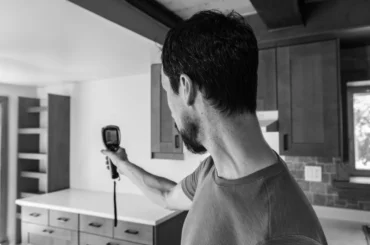Step into your home and take a deep breath. Ah, the comforting scent of… wait, what’s that? Stale air? Lingering odors? Don’t worry! In this guide, we’ll explore some creative and unconventional ways to improve the air quality in your home. Say goodbye to stuffy rooms and hello to a breath of fresh air that will invigorate both your space and your senses.
Well, buckle up because we’re about to dive into a world of innovative solutions that will revolutionize the way you think about the air you breathe at home. From harnessing the power of technology to embracing nature’s air purifiers, we’ll explore unconventional methods that will make your home a breath of fresh air—quite literally. Get ready to embark on a journey to a cleaner, crisper indoor air that will leave you wondering why you didn’t try these tricks sooner.
What is Air Quality in Home? – Understanding Indoor Air Quality
Air quality in the home refers to the condition of the air within a residential space. It encompasses various factors such as the presence of pollutants, the level of humidity, ventilation, and the overall cleanliness of the indoor environment. Good air quality means that the air is free from harmful substances and maintains a balance of temperature, humidity, and fresh airflow.
On the other hand, poor air quality can result in the accumulation of pollutants, allergens, and irritants, which can have negative effects on health, comfort, and overall well-being. Maintaining optimal air quality in the home is crucial for creating a healthy and pleasant living environment for occupants.
Why is Indoor Air Quality Important?
Indoor air quality directly affects our health, comfort, and overall well-being. Poor air quality can lead to symptoms like headaches, fatigue, allergies, and respiratory issues. It is especially crucial to maintain good air quality in homes, as we spend a significant amount of time indoors.
Common Indoor Air Pollutants
Before learning how to check air quality in your home, it’s essential to understand the common pollutants that can be present indoors. Some common indoor air pollutants include:
- Volatile Organic Compounds (VOCs) from cleaning products, paints, and furniture.
- Allergens like dust mites, pet dander, and pollen.
- Mold and mildew.
- Tobacco smoke.
- Carbon monoxide (CO) from gas appliances.
- Radon gas.
- Particulate matter from combustion sources.
What to Check for Air Quality in Your Home?
Use Air Quality Monitors
Air quality monitors are devices that measure and display the levels of various pollutants in your home. They can provide real-time data on pollutants like VOCs, particulate matter, and carbon dioxide. Place them strategically in different areas of your home to get a comprehensive understanding of the air quality.
Assess Ventilation Systems
Proper ventilation plays a crucial role in maintaining good air quality. Check your ventilation systems, including air ducts, filters, and exhaust fans, to ensure they are clean and functioning optimally. Poor ventilation can lead to a buildup of pollutants indoors.
Check for Mold and Moisture
Inspect your home for signs of mold and moisture. Mold growth can release spores into the air, causing respiratory issues. Address any leaks or moisture problems promptly and consider professional help for mold remediation if needed.
Monitor Carbon Monoxide Levels
Carbon monoxide is a silent and potentially deadly gas. Install carbon monoxide detectors in your home, especially near sleeping areas and fuel-burning appliances like furnaces and stoves. Regularly check and replace the batteries to ensure their proper functioning.
How to Improve Air Quality in Home?
Regular Cleaning and Dusting
Regular cleaning and dusting help reduce the accumulation of dust, allergens, and other pollutants. Vacuum carpets, mop floors, and wipe surfaces using microfiber cloths to trap dust effectively.
Proper Ventilation
Open windows and doors whenever possible to allow fresh air to circulate. Use exhaust fans in bathrooms and kitchens to remove pollutants generated during cooking and showering.
Avoiding Tobacco Smoke Indoors
Tobacco smoke contains numerous harmful chemicals and pollutants. Avoid smoking indoors and encourage smokers to do so outside the house.
Maintaining Optimal Humidity Levels
High humidity can lead to mold growth, while low humidity can cause dryness and discomfort. Aim for humidity levels between 30% and 50% and use humidifiers or dehumidifiers as needed.
Choosing Non-Toxic Cleaning Products
Opt for non-toxic and environmentally friendly cleaning products to minimize the release of harmful chemicals into the air.
Using Air Purifiers and Filters
Air purifiers with HEPA filters can help remove airborne particles and improve air quality. Consider using them in rooms where you spend the most time, such as bedrooms and living rooms.
Bringing in Plants for Natural Air Purification:
Certain indoor plants, such as peace lilies, spider plants, and aloe vera, can naturally filter and purify the air by absorbing pollutants and releasing oxygen. Add some greenery to your home for improved air quality.
How to Test the Air Quality in Your Home?
DIY Air Quality Test Kits
You can purchase DIY air quality test kits that provide basic measurements for common pollutants. These kits typically include air sampling devices and instructions for sample collection. Follow the instructions carefully and send the samples to a certified laboratory for analysis.
Professional Air Quality Testing Services
For a more comprehensive assessment, consider hiring a professional air quality testing service. They have specialized equipment and expertise to analyze air samples and provide detailed reports on pollutant levels in your home.
Conclusion
Maintaining good air quality in your home is vital for your health and well-being. By following the steps outlined in this guide, you can effectively check and improve air quality in your home. Regular monitoring, proper ventilation, and adopting healthy practices will ensure a cleaner and healthier living environment for you and your loved ones.
Remember, a proactive approach towards air quality will result in a safer and more comfortable home. Start implementing these measures today to breathe easy and enjoy the benefits of fresh, clean air within your living space.

